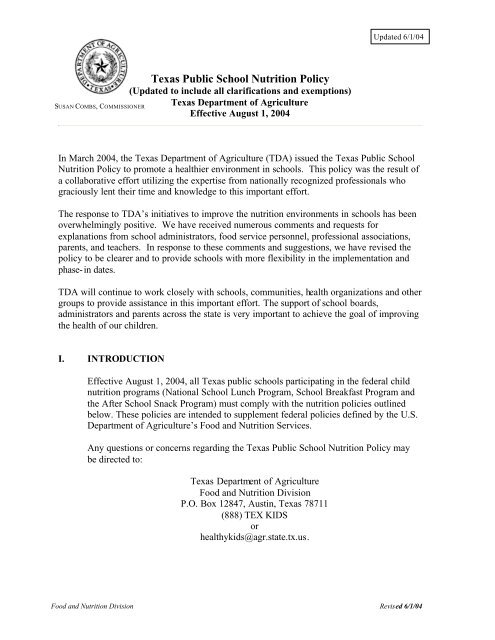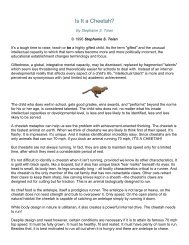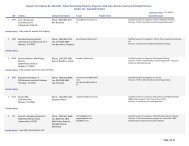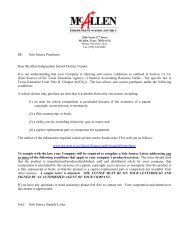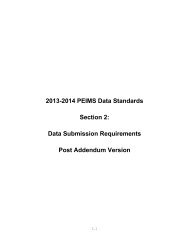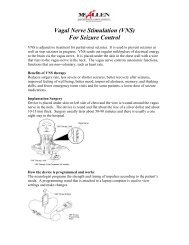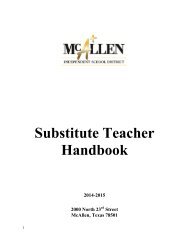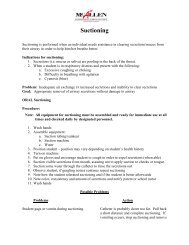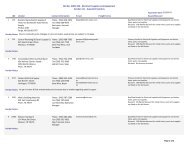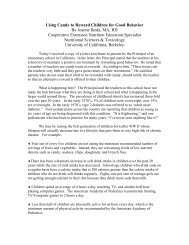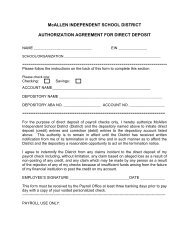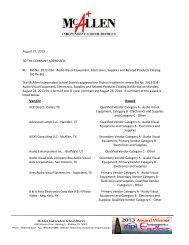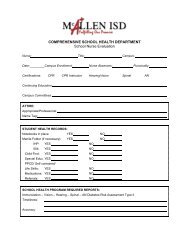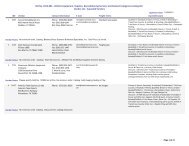Texas Public School Nutrition Policy
Texas Public School Nutrition Policy
Texas Public School Nutrition Policy
You also want an ePaper? Increase the reach of your titles
YUMPU automatically turns print PDFs into web optimized ePapers that Google loves.
Updated 6/1/04SUSAN COMBS, COMMISSIONER<strong>Texas</strong> <strong>Public</strong> <strong>School</strong> <strong>Nutrition</strong> <strong>Policy</strong>(Updated to include all clarifications and exemptions)<strong>Texas</strong> Department of AgricultureEffective August 1, 2004In March 2004, the <strong>Texas</strong> Department of Agriculture (TDA) issued the <strong>Texas</strong> <strong>Public</strong> <strong>School</strong><strong>Nutrition</strong> <strong>Policy</strong> to promote a healthier environment in schools. This policy was the result ofa collaborative effort utilizing the expertise from nationally recognized professionals whograciously lent their time and knowledge to this important effort.The response to TDA’s initiatives to improve the nutrition environments in schools has beenoverwhelmingly positive. We have received numerous comments and requests forexplanations from school administrators, food service personnel, professional associations,parents, and teachers. In response to these comments and suggestions, we have revised thepolicy to be clearer and to provide schools with more flexibility in the implementation andphase-in dates.TDA will continue to work closely with schools, communities, health organizations and othergroups to provide assistance in this important effort. The support of school boards,administrators and parents across the state is very important to achieve the goal of improvingthe health of our children.I. INTRODUCTIONEffective August 1, 2004, all <strong>Texas</strong> public schools participating in the federal childnutrition programs (National <strong>School</strong> Lunch Program, <strong>School</strong> Breakfast Program andthe After <strong>School</strong> Snack Program) must comply with the nutrition policies outlinedbelow. These policies are intended to supplement federal policies defined by the U.S.Department of Agriculture’s Food and <strong>Nutrition</strong> Services.Any questions or concerns regarding the <strong>Texas</strong> <strong>Public</strong> <strong>School</strong> <strong>Nutrition</strong> <strong>Policy</strong> maybe directed to:<strong>Texas</strong> Department of AgricultureFood and <strong>Nutrition</strong> DivisionP.O. Box 12847, Austin, <strong>Texas</strong> 78711(888) TEX KIDSorhealthykids@agr.state.tx.us.Food and <strong>Nutrition</strong> Division Revised 6/1/04
<strong>Texas</strong> <strong>Public</strong> <strong>School</strong> <strong>Nutrition</strong> <strong>Policy</strong>, RevisedEffective August 1, 2004Page 2 of 15II.DEFINITIONSThe following definitions apply to the <strong>Texas</strong> <strong>Public</strong> <strong>School</strong> <strong>Nutrition</strong> <strong>Policy</strong>:A. A La Carte: Refers to individually priced food items provided by the schoolfood service department. These items may or may not be part of thereimbursable meal.B. Competitive Foods: Foods and beverages sold or made available to studentsthat compete with the school’s operation of the National <strong>School</strong> LunchProgram, <strong>School</strong> Breakfast Program and/or After <strong>School</strong> Snack Program.This definition includes, but is not limited to, food and beverages sold orprovided in vending machines, in school stores or as part of schoolfundraisers. <strong>School</strong> fundraisers include food sold by school administrators orstaff (principals, coaches, teachers, etc.), students or student groups, parents orparent groups, or any other person, company or organization.C. FMNV: Foods of Minimal <strong>Nutrition</strong>al Value. Refers to the four categories offoods and beverages (soda water, water ices, chewing gum, and certaincandies) that are restricted by the U. S. Department of Agriculture under thechild nutrition programs. (See Section VI.)D. Food Service: Refers to the school’s operation of the National <strong>School</strong>Program, <strong>School</strong> Breakfast Program and After <strong>School</strong> Snack Programs andincludes all food service operations conducted by the school principally forthe benefit of schoolchildren, all of the revenue from which is used solely forthe operation or improvement of such food services.E. Fried Foods: Foods that are cooked by total immersion into hot oil or otherfat, commonly referred to as “deep fat frying.” This definition does notinclude foods that are stir-fried or sautéed.F. Fruit or Vegetable Drink: Beverages labeled as containing fruit orvegetable juice in amounts less than 100 percentG. Fruit or Vegetable Juice: Beverages labeled as containing 100 percent fruitor vegetable juice.H. <strong>School</strong> Day: The school day begins with the start of the first breakfast periodand continues until the end of the last instruction period of the day (last bell).Food and <strong>Nutrition</strong> Division Revised 6/1/04
<strong>Texas</strong> <strong>Public</strong> <strong>School</strong> <strong>Nutrition</strong> <strong>Policy</strong>, RevisedEffective August 1, 2004Page 3 of 15I. <strong>School</strong> Meals: Meals provided under the National <strong>School</strong> Lunch Program,<strong>School</strong> Breakfast Program and After <strong>School</strong> Snack Program for which schoolsreceive reimbursement in accordance with all applicable federal regulations,policies, instructions and guidelines.J. Snacks: Defined as either competitive foods or a la carte (see definitionsabove), depending on whether or not they are provided by the school foodservice department.K. Trans Fat: Occurs in foods when manufacturers use hydrogenation, aprocess in which hydrogen is added to vegetable oil to turn the oil into a moresolid (saturated) fat. Trans fats may be found in such foods as margarine,crackers, candies, cookies, snack foods, fried foods, baked goods, saladdressings and other processed foods.III.ELEMENTARY SCHOOLSFor purposes of this policy, an elementary school campus is defined as any campuscontaining a combination of grades EE-6. K-12 schools may follow the policyrequirements designated for middle and junior high schools.A. Foods of Minimal <strong>Nutrition</strong>al Value (FMNV) <strong>Policy</strong>Elementary school campuses may not serve or provide access for students toFMNV and all other forms of candy at any time anywhere on school premisesuntil the end of the last scheduled class. For exemptions and a listing of foodsand beverages restricted by the FMNV policy, see Section VI (below).Such foods and beverages may not be sold or given away to students onschool premises by school administrators or staff (principals, coaches,teachers, etc.), students or student groups, parents or parent groups, or anyother person, company or organization.B. <strong>Nutrition</strong> StandardsThe following specific nutrition standards pertain to all foods and beveragesserved or made available to students on elementary school campuses. Thisincludes school meals, a la carte and the nutritious classroom snacks.1. Fats and Fried Foods:a) <strong>School</strong>s and other vendors may not serve food items containingmore than 28 grams of fat per serving size more than twice perweek. The goal is to reduce this to 23 grams of fat per serving sizeby the start of the 2006-07 school year.Food and <strong>Nutrition</strong> Division Revised 6/1/04
<strong>Texas</strong> <strong>Public</strong> <strong>School</strong> <strong>Nutrition</strong> <strong>Policy</strong>, RevisedEffective August 1, 2004Page 4 of 15b) French fries and other fried potato products must not exceed 3ounces per serving, may not be offered more than once per week,and students may only purchase one serving at a time. (This doesnot pertain to potato chips, which are mentioned specifically in“2. Portion Sizes,” below.) We recommend that all such productsbe baked instead of fried.c) Baked potato products (wedges, slices, whole, new potatoes) thatare produced from raw potatoes and have not been pre-fried, flashfriedor deep fat-fried in any way may be served withoutrestriction.d) <strong>School</strong>s should eliminate frying as a method of on-site preparationfor foods served as part of school meals, a la carte, snack lines andcompetitive foods. This policy should be implemented by the2005-06 school year in schools that do not need to makeequipment changes or facility modifications to do so. A transitionperiod for implementation is allowed for schools needing to makeequipment changes or facility modifications, but all schools mustbe in compliance by the 2009-10 school year.e) Foods that have been flash-fried by the manufacturer may beserved but should be baked or heated by another method.f) Beginning with the 2005-06 school year, schools should include arequest for trans fat information in all product specifications.Beginning with the 2007-08 school year, schools should reduce thepurchase of any products containing trans fats. (Federal labelingof trans fats on all food products is required by January 1, 2006.)2. Portion Sizes:a) The following maximum portion size restrictions pertain to allfoods and beverages served or made available to students onschool campuses with the exception of school meals, which aregoverned by USDA regulations.Food or BeverageChips (regular).Chips (baked or no more than 7.5 grams of fat perbag), crackers, popcorn, cereal, trail mix, nuts, seeds,dried fruit, jerky and pretzels.Cookies/cereal bars.Bakery items (e.g., pastries, muffins).(This excludes items that count as two-breadcomponents served/sold only at breakfast.)Portion Size1 ounce1.5 ounces2 ounces3 ouncesFood and <strong>Nutrition</strong> Division Revised 6/1/04
<strong>Texas</strong> <strong>Public</strong> <strong>School</strong> <strong>Nutrition</strong> <strong>Policy</strong>, RevisedEffective August 1, 2004Page 5 of 15Frozen desserts, ice cream, pudding and jello.Yogurt.Whole milk, flavored or unflavored. (Flavored milksmay contain no more than 30 grams total sugar per 8ounce serving.)Reduced fat milk (2 percent or less), flavored orunflavored. (Flavored milks may contain no morethan 30 grams total sugar per 8 ounce serving.)Beverages (other than milk) may contain no morethan 30 grams total sugar per 8 ounce serving. Nolimit on non-carbonated, unflavored bottled water.Frozen fruit slushes (must contain a minimum of 50percent fruit juice).4 ounces8 ounces8 ounces16 ounces12 ounces6 ounces3. Other:b) The maximum portion size restrictions provided by this policy donot apply where existing contracts require the vending of largervolume containers or package sizes. Contracts and contractrenewals executed after March 3, 2004, must expressly complywith this policy.a) Fruit and/or vegetables should be offered daily on all points ofservice. Fruits and vegetables should be fresh whenever possible.Frozen and canned fruits should be packed in natural juice, wateror light syrup.b) <strong>School</strong>s must offer 2 percent, 1 percent or skim milk at all pointswhere milk is served.c) It is the goal of this policy that all beverages served in elementaryschools would be milk, unflavored water and 100 percent fruitand/or vegetable juice by the start of the 2006-07 school year.d) <strong>School</strong>s serving chips should use reduced fat (no more than 5grams of fat per ounce) or baked varieties whenever possible.C. Competitive Foods and SnacksAn elementary school campus may not serve competitive foods (or provideaccess to them through direct or indirect sales) to students anywhere on schoolpremises throughout the school day until the end of the last scheduled class.This does not pertain to food items made available by the school food servicedepartment.Elementary classrooms may allow one nutritious snack per day under theteacher’s supervision. The snack may be in the morning or afternoon but mayFood and <strong>Nutrition</strong> Division Revised 6/1/04
<strong>Texas</strong> <strong>Public</strong> <strong>School</strong> <strong>Nutrition</strong> <strong>Policy</strong>, RevisedEffective August 1, 2004Page 6 of 15not be at the same time as the regular meal periods for that class. The snackmay be provided by the school food service, the teacher, parents or othergroups and should be at no cost to students.The snack must comply with the fat and sugar limits of the <strong>Public</strong> <strong>School</strong><strong>Nutrition</strong> <strong>Policy</strong> and may not contain any FMNVs or consist of candy ordessert type items (cookies, cakes, cupcakes, pudding, ice cream or frozendesserts, etc.). Please refer to the attached revised suggestions for nutritioussnacks.IV.MIDDLE/JUNIOR HIGH SCHOOLSFor purposes of this policy, a middle school campus is defined as a campuscontaining grades 6, 7 and 8. A junior high school campus may contain either grades7 and 8, or grades 7, 8 and 9. K-12 schools may follow the policy requirementsdesignated for middle and junior high schools.A. Foods of Minimal <strong>Nutrition</strong>al Value (FMNV) <strong>Policy</strong>Middle school and junior high school campuses may not serve or provideaccess for students to FMNV and all other forms of candy at any timeanywhere on school premises until after the end of the last lunch period. Forexemptions and a listing of foods and beverages restricted by the FMNVpolicy, see Section VI (below).B. <strong>Nutrition</strong> StandardsThe following specific nutrition standards pertain to all foods and beveragesserved or made available in school meals, a la carte and competitive foods tostudents on middle and junior high school campuses.1. Fats and Fried Foods:a) <strong>School</strong>s and other vendors may not serve food items containingmore than 28 grams of fat per serving size more than twice perweek. The goal is to reduce this to 23 grams of fat per serving sizeby the start of the 2006-07 school year.b) French fries and other fried potato products must not exceed 3ounces per serving, may not be offered more than three times perweek, and students may only purchase one serving at a time. (Thisdoes not pertain to potato chips, which are mentioned specificallyin “2. Portion Sizes,” below.) We recommend that all suchproducts be baked instead of fried.Food and <strong>Nutrition</strong> Division Revised 6/1/04
<strong>Texas</strong> <strong>Public</strong> <strong>School</strong> <strong>Nutrition</strong> <strong>Policy</strong>, RevisedEffective August 1, 2004Page 7 of 15c) Baked potato products (wedges, slices, whole, new potatoes) thatare produced from raw potatoes and have not been pre-fried, flashfriedor deep fat-fried in any way may be served withoutrestriction.d) <strong>School</strong>s should eliminate frying as a method of on-site preparationfor foods served as part of school meals, a la carte, snack lines andcompetitive foods. This policy should be implemented by the2005-06 school year in schools that do not need to makeequipment changes or facility modifications to do so. A transitionperiod for implementation is allowed for schools needing to makeequipment changes or facility modifications, but all schools mustbe in compliance by the 2009-10 school year.e) Foods that have been flash-fried by the manufacturer may beserved but should be baked or heated by another method.f) Beginning with the 2005-06 school year, schools should include arequest for trans fat information in all product specifications.Beginning with the 2007-08 school year, schools should reduce thepurchase of any products containing trans fats. (Federal labeling oftrans fats on all food products is required by January 1, 2006.)2. Portion Sizes:a) The following maximum portion size restrictions pertain to allfoods and beverages served or made available to students onschool campuses with the exception of school meals, which aregoverned by USDA regulations.Food or BeverageChips (regular).Chips (baked or no more than 7.5 grams of fatper bag), crackers, popcorn, cereal, trail mix,nuts, seeds, dried fruit, jerky and pretzels.Cookies/cereal bars.Bakery items (e.g., pastries, muffins).(This excludes items that count as two-breadcomponents served/sold only at breakfast.)Frozen desserts, ice cream, pudding and jello.Yogurt.Whole milk, flavored or unflavored.(Flavored milks may contain no more than 30grams total sugar per 8 ounce serving.)Reduced fat milk (2 percent or less), flavoredor unflavored. (Flavored milks may containPortion Size1 ounce1.5 ounces2 ounces3 ounces4 ounces8 ounces8 ounces16 ouncesFood and <strong>Nutrition</strong> Division Revised 6/1/04
<strong>Texas</strong> <strong>Public</strong> <strong>School</strong> <strong>Nutrition</strong> <strong>Policy</strong>, RevisedEffective August 1, 2004Page 8 of 15no more than 30 grams total sugar per 8 ounceserving.)Beverages (other than milk) and thoserestricted as FMNVs may contain no morethan 30 grams total sugar per 8 ounce serving.No limit on non-carbonated, unflavoredbottled water.Candy bars and packaged candies.Frozen fruit slushes (must contain a minimumof 50 percent fruit juice).12 ounces1.5 ounces12 ounces3. Other:C. Competitive Foodsb) The maximum portion size restrictions provided by this policy donot apply where existing contracts require the vending of largervolume containers or package sizes. Contracts and contractrenewals executed after March 3, 2004, must expressly complywith this policy.a) Fruit and/or vegetables should be offered daily on all points ofservice. Fruits and vegetables should be fresh whenever possible.Frozen and canned fruits should be packed in natural juice, wateror light syrup.b) <strong>School</strong>s must offer 2 percent, 1 percent or skim milk at all pointswhere milk is served.c) <strong>School</strong>s serving chips should use reduced fat (no more than 5grams of fat per ounce) or baked varieties whenever possible.A middle or junior high school campus may not serve competitive foods (orprovide access to them through direct or indirect sales) to students anywhereon school premises during meal periods. This does not pertain to food itemsmade available by the school food service department. The competitive foodsincluded in this policy do not include FMNVs, which are not allowed untilafter the last lunch period.V. HIGH SCHOOLSFor purposes of this policy, a high school campus is defined as any campuscontaining a combination of grades 9, 10, 11 and 12. K-12 schools may follow thepolicy requirements designated for middle and junior high schools.Food and <strong>Nutrition</strong> Division Revised 6/1/04
<strong>Texas</strong> <strong>Public</strong> <strong>School</strong> <strong>Nutrition</strong> <strong>Policy</strong>, RevisedEffective August 1, 2004Page 9 of 15A. Foods of Minimal <strong>Nutrition</strong>al Value (FMNV)1. <strong>Policy</strong>: High schools may not serve or provide access to FMNVduring meal periods in areas where reimbursable meals are servedand/or consumed. For exemptions and a listing of foods and beveragesrestricted by the FMNV policy, see Section VI (below).New contracts and contract renewals executed after March 3, 2004,must expressly prohibit the sale of sugared, carbonated beverages incontainers larger than 12 ounces.2. Goal: It is the <strong>Texas</strong> Department of Agriculture’s goal that, by the2005-06 school year, no more than 30 percent of the beverages madeavailable through vending machines on high school campuses shouldbe sugared, carbonated soft drinks. Furthermore, it is our goal to limitsugared, carbonated beverages to containers holding no more than 12ounces.B. <strong>Nutrition</strong> StandardsThe following specific nutrition standards pertain to all foods and beveragesserved or made available in school meals, a la carte and competitive foods tostudents on high school campuses.1. Fats and Fried Foods:a) <strong>School</strong>s and other vendors may not serve food items containingmore than 28 grams of fat per serving size more than twice perweek. The goal is to reduce this to 23 grams of fat per serving sizeby the start of the 2006-07 school year.b) French fries and other fried potato products must not exceed 3ounces per serving, and students may only purchase one serving ata time. (This does not pertain to potato chips, which are mentionedspecifically in “2. Portion Sizes,” below.) We recommend that allsuch products be baked instead of fried.c) Baked potato products (wedges, slices, whole, new potatoes) thatare produced from raw potatoes and have not been pre-fried, flashfriedor deep fat-fried in any way may be served withoutrestriction.d) <strong>School</strong>s should eliminate frying as a method of on-site preparationfor foods served as part of school meals, a la carte, snack lines andcompetitive foods. This policy should be implemented by the2005-06 school year in schools that do not need to makeFood and <strong>Nutrition</strong> Division Revised 6/1/04
<strong>Texas</strong> <strong>Public</strong> <strong>School</strong> <strong>Nutrition</strong> <strong>Policy</strong>, RevisedEffective August 1, 2004Page 10 of 15equipment changes or facility modifications to do so. A transitionperiod for implementation is allowed for schools needing to makeequipment changes or facility modifications, but all schools mustbe in compliance by the 2009-10 school year.e) Foods that have been flash-fried by the manufacturer may beserved but should be baked or heated by another method.f) Beginning with the 2005-06 school year, schools should include arequest for trans fat information in all product specifications.Beginning with the 2007-08 school year, schools should reduce thepurchase of any products containing trans fats. (Federal labeling oftrans fats on all food products is required by January 1, 2006.)2. Portion Sizes:a) The following maximum portion size restrictions pertain to allfoods and beverages served or made available to students onschool campuses with the exception of school meals, which aregoverned by USDA regulations.Food or BeverageChips (regular)Chips (baked or no more than 7.5 grams of fatper bag), crackers, popcorn, cereal, trail mix,nuts, seeds, dried fruit, jerky and pretzels.Cookies/cereal bars.Bakery items (e.g., pastries, muffins).(This excludes items that count as two-breadcomponents served/sold only at breakfast.)Frozen desserts, ice cream, jello and pudding.Yogurt.Whole milk, flavored or unflavored. (Flavoredmilks may contain no more than 30 grams totalsugar per 8 ounce serving.)Reduced fat milk (2 percent or less), flavored orunflavored. (Flavored milks may contain nomore than 30 grams total sugar per 8 ounceserving.)Beverages (other than milk) and those restrictedas FMNVs may contain no more than 30 gramstotal sugar per 8 ounce serving. No limit onnon-carbonated, unflavored bottled water.Candy bars and packaged candies.Frozen fruit slushes (must contain a minimumof 50 percent fruit juice).Portion Size1.25 ounces1.5 ounces2 ounces3 ounces4 ounces8 ounces8 ounces16 ounces12 ounces1.5 ounces12 ouncesFood and <strong>Nutrition</strong> Division Revised 6/1/04
<strong>Texas</strong> <strong>Public</strong> <strong>School</strong> <strong>Nutrition</strong> <strong>Policy</strong>, RevisedEffective August 1, 2004Page 11 of 153. Other:C. Competitive Foodsb) The maximum portion size restrictions provided by this policy donot apply where existing contracts require the vending of largervolume containers or package sizes. Contracts and contractrenewals executed after March 3, 2004, must expressly complywith this policy.a) Fruit and/or vegetables should be offered daily on all points ofservice. Fruits and vegetables should be fresh whenever possible.Frozen and canned fruits should be packed in natural juice, wateror light syrup.b) <strong>School</strong>s must offer 2 percent, 1 percent or skim milk at all pointswhere milk is served.c) <strong>School</strong>s serving chips should use reduced fat (no more than 5grams of fat per ounce) or baked varieties whenever possible.High schools may not serve or provide access to competitive foods duringmeal periods in areas where reimbursable meals are served and/or consumed.This does not pertain to food items made available by the school food servicedepartment. All competitive foods sold or provided to students must meet thenutrition standards listed in Section V, B (above) of this policy.Food and <strong>Nutrition</strong> Division Revised 6/1/04
<strong>Texas</strong> <strong>Public</strong> <strong>School</strong> <strong>Nutrition</strong> <strong>Policy</strong>, RevisedEffective August 1, 2004Page 12 of 15VI.FOODS OF MINIMAL NUTRITIONAL VALUE (FMNV)Federal regulations prohibit the sale of certain foods, determined to be of minimalnutritional value, in the foodservice area during meal periods.A. Restricted FoodsFoods and beverages that are restricted from sale to students are classified inthe following four categories:1. Soda Water: Any carbonated beverage. No product shall be excludedfrom this definition because it contains discrete nutrients added to thefood such as vitamins, minerals and protein.2. Water Ices: Any frozen, sweetened water such as “...sicles” andflavored ice with the exception of products that contain fruit or fruitjuice.3. Chewing Gum: Any flavored products from natural or syntheticgums and other ingredients that form an insoluble mass for chewing.4. Certain Candies: Any processed foods made predominantly fromsweeteners or artificial sweeteners with a variety of minor ingredientsthat characterize the following types:a) Hard Candy: A product made predominantly from sugar(sucrose) and corn syrup that may be flavored and colored, and ischaracterized by a hard, brittle texture. Includes such items as sourballs, lollipops, fruit balls, candy sticks, starlight mints, afterdinner mints, jaw breakers, sugar wafers, rock candy, cinnamoncandies, breath mints and cough drops.b) Jellies and Gums: A mixture of carbohydrates that are combinedto form a stable gelatinous system of jellylike character and aregenerally flavored and colored, and include gum drops, jelly beans,jellied and fruit-flavored slices.c) Marshmallow Candies: An aerated confection composed ofsugar, corn syrup, invert sugar, 20 percent water, and gelatin oregg white to which flavors and colors may be added.d) Fondant: A product consisting of microscopic-sized sugarcrystals that are separated by a thin film of sugar and/or invertsugar in solution such as candy corn or soft mints.Food and <strong>Nutrition</strong> Division Revised 6/1/04
<strong>Texas</strong> <strong>Public</strong> <strong>School</strong> <strong>Nutrition</strong> <strong>Policy</strong>, RevisedEffective August 1, 2004Page 13 of 15e) Licorice: A product made predominantly from sugar and cornsyrup that is flavored with an extract made from the licorice root.f) Spun Candy: A product that is made from sugar that has beenboiled at high temperature and spun at a high speed in a specialmachine.g) Candy Coated Popcorn: Popcorn that is coated with a mixturemade predominantly from sugar and corn syrup.Note: USDA has approved exceptions for certain products included inthe above categories. See TDA, Food and <strong>Nutrition</strong> Division,Administrators Reference Manual, for the current list of theseexemptions.B. FMNV and <strong>Policy</strong> Exemptions1. <strong>School</strong> Nurses: This policy does not apply to school nurses usingFMNVs during the course of providing health care to individualstudents.2. Accommodating Students with Special Needs: Special NeedsStudents whose Individualized Education Program (IEP) plan indicatesthe use of an FMNV or candy for behavior modification (or othersuitable need) may be given FMNV or candy items.3. <strong>School</strong> Events: Students may be given FMNV, candy items or otherrestricted foods during the school day for up to three different eventseach school year to be determined by campus. The exempted eventsmust be approved by a school official. During these events, FMNVmay not be given during meal times in the areas where school mealsare being served or consumed, and regular meal service (breakfast andlunch) must continue to be available to all students in accordance withfederal regulations.4. TAKS Test Days: <strong>School</strong>s and parents may provide one additionalnutritious snack per day for students taking the TAKS tests. The snackmust comply with the fat and sugar limits of the <strong>Public</strong> <strong>School</strong><strong>Nutrition</strong> <strong>Policy</strong> and may not contain any foods of minimal nutritionalvalue or consist of candy, chips or dessert type items (cookies, cakes,cupcakes, pudding, ice cream or frozen desserts, etc.). Please refer tothe attached revised suggestions for nutritious snacks.Food and <strong>Nutrition</strong> Division Revised 6/1/04
<strong>Texas</strong> <strong>Public</strong> <strong>School</strong> <strong>Nutrition</strong> <strong>Policy</strong>, RevisedEffective August 1, 2004Page 14 of 155. Instructional Use of Food in Classroom: For instructional purposes,teachers may use foods as long as the food items are not consideredFMNV or candy. Students may consume food prepared in class forinstructional purposes. However, this should be on an occasional basis,and food may not be provided or sold to other students or classes.Food provided for students as part of a class or school cultural heritageevent for instructional or enrichment purposes would be exempt fromthe policy. However, FMNV may not be served during meal periods inthe areas where school meals are being served or consumed, andregular meal service (breakfast and lunch) must continue to beavailable to all students.6. Field Trips: <strong>School</strong>-approved field trips are exempt from thenutrition policy. A school official must approve the dates and purposesof the field trips in advance.7. Athletic, UIL, Band and Other Competitions: The nutrition policydoes not apply to students who leave campus to travel to athletic, UIL,band or other competitions. The school day is considered to haveended for these students. <strong>School</strong> activities, athletic functions, etc. thatoccur after the normal school day are not covered by the policy.C. This policy does not restrict what parents may provide for their own child’slunch or snacks. Parents may provide FMNV or candy items for their ownchild’s consumption, but they may not provide restricted items to otherchildren at school. A school may adopt a more restrictive rule, however, aslocal policy.Food and <strong>Nutrition</strong> Division Revised 6/1/04
<strong>Texas</strong> <strong>Public</strong> <strong>School</strong> <strong>Nutrition</strong> <strong>Policy</strong>, RevisedEffective August 1, 2004Page 15 of 15VII.HEALTHY NUTRITION ENVIRONMENTAll school cafeterias and dining areas should be healthy nutrition environments.<strong>Texas</strong> public schools participating in federal child nutrition programs should ensurethat all students have daily access to school meals (breakfast and lunch). <strong>School</strong>sshould not establish policies, class schedules, bus schedules or other barriers thatdirectly or indirectly restrict meal access.Adequate time should be allowed for students to receive and consume meals, andcafeterias should provide a pleasant dining environment. The minimum recommendedeating time for each student after being served is at least 10 minutes for breakfast and20 minutes for lunch.We encourage all school districts to adhere closely to the coordinated school healthand physical activity components of the <strong>Texas</strong> Education Code. It is stronglyrecommended that PE or recess should be scheduled before lunch whenever possible.VIII. COMPLIANCE AND PENALTIESThe <strong>Texas</strong> Department of Agriculture (TDA) administers the National <strong>School</strong> LunchProgram, <strong>School</strong> Breakfast Program and After <strong>School</strong> Snack Program through itsFood and <strong>Nutrition</strong> Division. Responsibilities include processing claims forreimbursement, providing special marketing projects and procurement assistance topromote more nutritious eating habits, conducting on-site compliance monitoring andcoordinating training through the 20 regional Education Service Centers.TDA will aggressively enforce and diligently monitor the <strong>Texas</strong> <strong>School</strong> <strong>Nutrition</strong><strong>Policy</strong> to ensure compliance. When violations of this policy are noted, TDA willdisallow all meal reimbursement for the day and require the school to reimburse thefood service account for the lost reimbursement. A documented corrective action planwill be required and will be monitored diligently to ensure continued compliance.Food and <strong>Nutrition</strong> Division Revised 6/1/04


